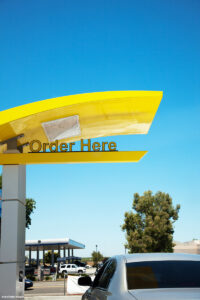Are Drive-Thru Lanes Hitting the Road?
It’s been a long day of school and practice. You’re starving, but you don’t have a lot of money or time. What will you do? If you’re like most Americans, you’ll go through the drive-thru line of your favorite fast food restaurant. But that might be getting harder to do, as some cities are now passing laws prohibiting new drive-thru windows from being built.
Why the Ban?
So why are cities trying to get between citizens and their French fry habits? Several reasons, actually. The first is environmental: cars idling in drive-thru lines produce emissions of damaging greenhouse gases. Drive-thru lines also produce litter, and eliminating that has been shown to improve pedestrian safety and walkability. Some cities have also banned these restaurant conveniences in an attempt to lower rates of obesity, but critics argue that there is no concrete evidence to support this connection. (In fact, the rates of obesity in some cities have actually gone up in the years since fast-food bans were put into place there.) Instead, more effective ways to curb obesity have been to list the calorie counts on fast-food menu items, and to impose so-called “soda taxes” to raise the price of sugary soft drinks.
So far, only a handful of cities have passed such drive thru bans. But at least from a public health standpoint, experts say that it would be more effective to pass legislation requiring fast-food restaurants to provide healthful food options.
When a Minute Feels Like Forever…

Even if you live in a city that allows fast-food drive-thrus to exist, you might find that the lines aren’t always all that . . . well, fast. But some take longer than others. Believe it or not, an annual study breaks down the drive-thru lines of national chains to determine which ones are the fastest and which are the slowest. This year, the fastest drive-through line was Dunkin’ Donuts, with an average wait time of just under four minutes from the first window approach to completion of the order. Wendy’s, Carl’s Jr., and Burger King also had fast wait-times. The slowest, with an average wait time of almost five and a half minutes from the initial approach to order completion, was Chick-fil-A, followed by McDonald’s, Hardees, and Arby’s.
It seems impossible to measure such a thing objectively, because there are so many variables, such as size and specificity of the order. But QSR Magazine, which conducts the annual study, does its best to control for as many factors as possible. For example, every order is standardized, meaning that the same order is placed at each restaurant: a main item, side item, and drink. There is also a minor variation requested each time, such as no ice. All the meals are paid for with cash so that timing isn’t delayed by credit card transactions.
The study also determines times of day when lines are fastest and slowest. The results aren’t too surprising: breakfast service is the fastest, while late afternoon orders take the longest.
